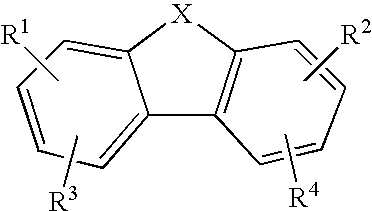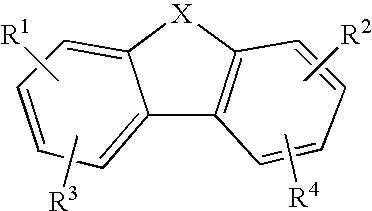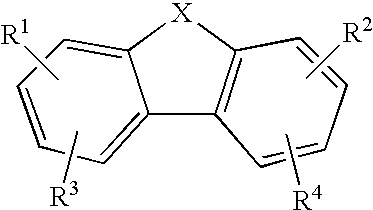Anti-malarial compounds
a technology of compounds and anti-malarial agents, applied in the field of anti-malarial compounds, can solve the problems of 10.7% of all children's deaths in developing countries
- Summary
- Abstract
- Description
- Claims
- Application Information
AI Technical Summary
Benefits of technology
Problems solved by technology
Method used
Image
Examples
example 1
Synthesis of Compounds 142 and 149
[0687]
[0688]Step 1: The diamine (0.1 mmol) and ({[(tert-butoxycarbonyl)amino][(tert-butoxycarbonyl)imino]methyl}amino)pentanoic acid (4 equivalence) were dissolved in 3 mL of pyridine and cooled to 0° C. The solution was added POCl3 (4 equiv.) dropwise and stirred at 0° C. for 1.5 hours. The reaction was quenched with ice water. The solvent was removed on a rotovap.
[0689]Step 2: The product from step 1 was treated with 50% trifluoroacetic acid (TFA) in dichloromethane (DCM). The product was purified by reverse phase chromatography.
example 2
Synthesis of Compounds 109, 111, and 144
[0690]
[0691]Step 1: 319.6 mg of 4,4-dihydroxyphenyl in 4.0 ml of dimethylformamide (DMF) were sequentially added to 839.0 mg of K2CO3, and 1.3166 g of 3,5-dinitrobenzotrifluoride. The reaction mixture was heated to 125° C. with stirring for overnight. TLC analysis indicated the starting material was consumed. The reaction was quenched with water and extracted with ethyl acetate (EtOAc) twice. The organic phase was washed with water, brine and dried with sodium sulfate before being concentrated under reduced pressure. The product was purified by column chromatography with a yield of 865.6 mg (69%).
[0692]Step 2: 312.3 mg of the product formed in step 1 in 5.0 ml of MeOH was sequentially added to 365.3 mg of NH4Cl, and 400.2 mg of Zinc dust. The reaction mixture was irradiated under microwave at 115° C. for 20 minutes. LCMS analysis indicated the starting material was consumed. The reaction mixture was filtered and concentrated. The residue was q...
example 3
Synthesis of Compounds 148 and 147
[0695]
[0696]Step 1: 1.1071 g of bis-(4,4-dihydroxyphenyl)-bis-(trifluoromethyl)-methane in 4.0 ml of DMF were sequentially added 1.36 g of K2CO3, and 1.2777 g of 4-fluoro3-trifluoromethylbenzaldehyde. The reaction mixture was heated to 130° C. and stirred for 6 hours. The reaction was quenched with water and extracted with EtOAc twice. The organic phase was washed with water, brine and dried with sodium sulfate before was concentrated under reduced pressure. The product was purified by column chromatography with a yield of 400.0 mg.
[0697]Step 2: 71.4 mg of dialdehyde formed in step 1 in 3.0 ml of dichloroethane was sequentially added 241.8 mg of piperazine-1-carboxylic acid tert-butyl ester, and 257.8 mg of NaBH(OAc)3. The reaction mixture was stirred at room temperature overnight. LCMS analysis indicated the starting material was consumed. The reaction mixture was concentrated and the residue was quenched with Na2CO3 solution and extracted with EtO...
PUM
| Property | Measurement | Unit |
|---|---|---|
| molecular weights | aaaaa | aaaaa |
| temperature | aaaaa | aaaaa |
| resistance | aaaaa | aaaaa |
Abstract
Description
Claims
Application Information
 Login to View More
Login to View More - R&D
- Intellectual Property
- Life Sciences
- Materials
- Tech Scout
- Unparalleled Data Quality
- Higher Quality Content
- 60% Fewer Hallucinations
Browse by: Latest US Patents, China's latest patents, Technical Efficacy Thesaurus, Application Domain, Technology Topic, Popular Technical Reports.
© 2025 PatSnap. All rights reserved.Legal|Privacy policy|Modern Slavery Act Transparency Statement|Sitemap|About US| Contact US: help@patsnap.com



